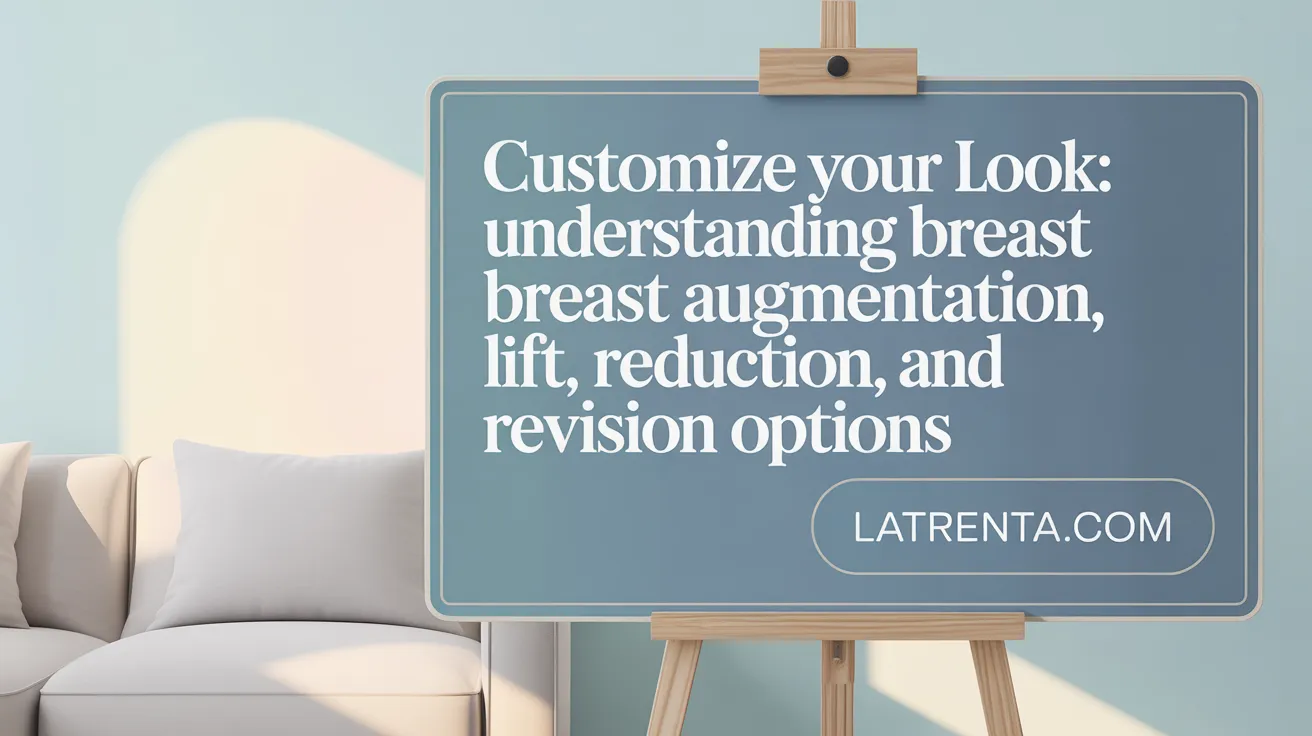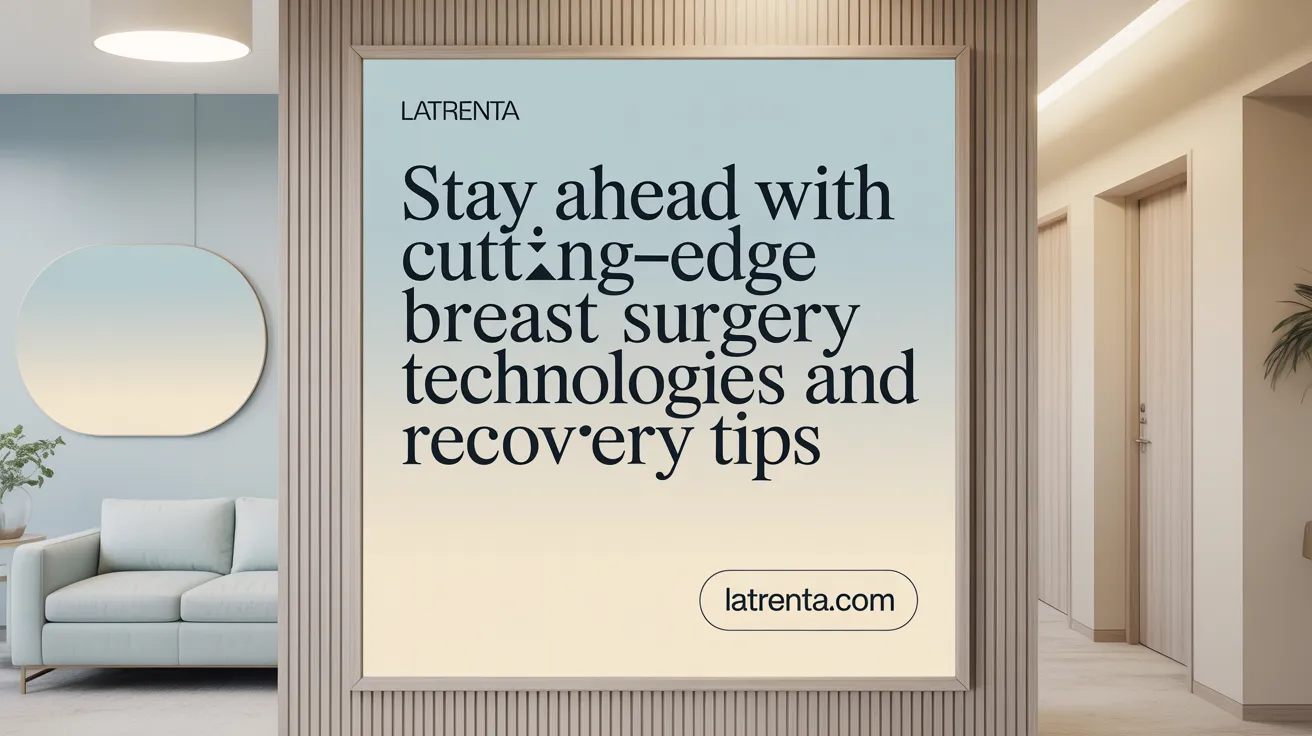Understanding Breast Aesthetic Enhancements
Breast aesthetic enhancements continue to be among the most sought-after cosmetic procedures, offering a blend of artistic customization and medical expertise to help individuals achieve their desired appearance and confidence. With various surgical options available, including augmentation, lifts, reductions, and revisions, selecting the procedure that best suits your anatomy, lifestyle, and goals requires careful consideration and informed decision-making. This article guides you through the types of procedures, implant choices, safety considerations, and recovery insights to empower you in making the best choices for your breast enhancement journey.
Types of Breast Aesthetic Enhancement Procedures and Their Characteristics

What are the different types of breast aesthetic enhancement procedures and their characteristics?
Breast aesthetic enhancement encompasses a variety of breast surgery options tailored to improve or alter the shape, size, and position of the breasts. Each surgical option serves specific aesthetic or medical goals.
Breast augmentation is one of the most common procedures, primarily aimed at increasing breast size and enhancing shape. It typically involves inserting silicone or saline implants, or using fat transfer techniques harvested from other parts of the body. The choice of implant type and surgical approach is customized based on the patient's body and desired outcome.
Breast lift, also known as mastopexy, is designed to correct sagging or drooping breasts caused by aging, gravity, pregnancy, or weight fluctuations. It involves removing excess skin and tightening the remaining tissue, often repositioning the nipple for a more youthful appearance. In many cases, a lift can be combined with augmentation if additional volume is desired.
Breast reduction surgery addresses excessively large, heavy breasts that may cause discomfort such as back, neck, or shoulder pain. This procedure involves removing excess fat, tissue, and skin, resulting in smaller, more proportionate breasts. Beyond aesthetic improvement, it also offers significant health and physical benefits.
Breast revision surgery is performed to amend previous breast procedures. It may involve replacing or removing implants, correcting asymmetries, or fixing complications like capsular contracture or malposition. Revision surgeries help maintain aesthetic results and resolve issues that may develop over time.
Fat transfer augmentation offers a natural alternative by using liposuction to harvest fat from areas like the thighs or abdomen, then injecting it into the breasts. This minimally invasive technique typically provides modest volume increases and is suited for women seeking a subtle enhancement.
Gynecomastia surgery, or male breast reduction, is a specialized procedure that removes excess glandular tissue and fat from enlarged male breasts. It aims to produce a flatter, more traditionally masculine chest contour.
In summary, these procedures—augmentation, lift, reduction, revision, and fat transfer—are distinct yet sometimes combined to achieve optimal aesthetic and functional outcomes tailored to individual needs. Consulting with a qualified plastic surgeon ensures the best personalized approach.
Choosing the Right Breast Augmentation Procedure: Factors to Consider

What factors should be considered when choosing a breast augmentation procedure?
Selecting the ideal breast augmentation procedure approach depends on a variety of personal and medical factors. Patients should start by considering their desired breast size and shape, which guide the choice toward specific implant types, shapes, and outcomes. For instance, implant options include saline, silicone, and the newer gummy bear (cohesive gel) implants, each offering different aesthetics and feel.
The shape of the implant also influences the final look. Round implants tend to add fullness and cleavage, while teardrop-shaped implants mimic natural breast contours. The surface texture—smooth or textured—is another consideration, with textured implants helping reduce movement but associated with a slightly increased risk of BIA-ALCL, a rare lymphoma.
Surgical options such as incision sites and implant placement are crucial. Common incision locations include inframammary (under the breast), periareolar (around the nipple), and transaxillary (through the armpit). Placement options generally involve subglandular (above the muscle) or submuscular (below the muscle) positioning, with the latter often preferred for a more natural appearance and lower visibility of the implant.
Body type and lifestyle should influence the decision. Women with different tissue qualities, skin elasticity, and activity levels may require tailored techniques to optimize results and longevity. For example, women with less natural tissue may prefer implants with specific profiles or shapes suitable for their lifestyle.
Choosing a qualified, experienced surgeon is vital. A board-certified plastic surgeon will evaluate individual anatomy, discuss goals, review risks including capsular contracture or rupture, and advise on the most suitable options. During consultation, realistic expectations and potential future surgeries should be discussed, as all implants have a limited lifespan—averaging around 10 years—and may need replacement or revision.
Safety guidelines from the FDA highlight the importance of informed consent and ongoing monitoring for rupture or complications. Patients should inquire about the surgeon’s complication rates, experience with different procedures, and volume of cases to ensure high-quality care.
In sum, an informed decision involves evaluating implant types, surgical techniques, personal anatomy, lifestyle, and surgeon expertise. Weighing these factors alongside understanding long-term risks—such as capsular contracture, implant rupture, or rare lymphomas—ensures a safe and satisfying outcome tailored to individual goals.
Breast Implant Options: Shapes, Sizes, Materials, and Placement
 When considering breast augmentation, understanding the variety of breast implants options is essential to achieving the desired aesthetic outcome. Breast implants are manufactured using different materials, shapes, sizes, and placement techniques, each offering distinct advantages tailored to individual needs.
When considering breast augmentation, understanding the variety of breast implants options is essential to achieving the desired aesthetic outcome. Breast implants are manufactured using different materials, shapes, sizes, and placement techniques, each offering distinct advantages tailored to individual needs.
Types of Implant Materials
Implant materials mainly include saline, silicone gel, and cohesive 'gummy bear' gel. Saline implants are filled with sterile salt water and are insertable empty, then filled to the desired volume during surgery. They are often used in cases where smaller incisions are preferred. Silicone gel implants contain a silicone-based gel that feels more natural and mimics real breast tissue, providing a softer, more authentic look and feel. Gummy bear implants are a form-stable, highly cohesive silicone gel that maintains shape even if the shell is broken. They are generally firmer but ideal for shaping and contour.
Shapes and Their Aesthetic Effects
Implant shapes significantly influence the breast profile. Round implants offer a fuller appearance, especially at the top, and are less prone to rotation. They tend to create more cleavage and are often chosen for a more dramatic enhancement. Teardrop or anatomically shaped implants resemble natural breasts with fuller volume at the bottom and thinner at the top, providing a more natural slope. The choice between round and teardrop depends on personal preference and the amount of projection or natural shape desired.
Sizes and Measurement
Implant sizes are measured in cubic centimeters (cc). Common sizes range from 150cc to over 800cc, with most women opting for between 275cc and 400cc. The size selected influences the final bra cup size, but individual body factors such as tissue capacity and desired appearance also play a role. For example, increasing from a small A cup to a large B or C cup typically involves 200-350cc implants. Surgeons often use sizing models or try-ons with sizers during consultation to help patients visualize outcomes. For more on breast implant sizing and how to choose, see available guides.
Profile and Projection
Profiles refer to the amount of projection the implant provides and are classified into low, moderate, high, and ultra-high. A high-profile implant extends further from the chest wall, creating a more dramatic look suitable for narrower chests. Conversely, low-profile implants are flatter and better suited for broader chests for a subtle, natural appearance. Learn more about breast implant profiles and projection.
Placement Options
Implant placement significantly impacts recovery, appearance, and potential complications. Subglandular placement rests over the chest muscle directly behind the gland, often resulting in easier surgery but higher visibility of rippling. Submuscular placement positions the implant underneath the pectoral muscle, offering a more natural contour, better coverage in women with thinner tissue, and lower risk of capsular contracture. Dual plane placement combines elements of both, with the implant partially under the muscle. The choice depends on the patient's body structure, activity level, and aesthetic goals.
Incision Sites and Their Implications
Common incision options include inframammary (beneath the breast fold), periareolar (around the nipple), transaxillary (armpit), and transumbilical (through the belly button). The inframammary approach is most popular due to precise implant placement and minimal impact on breastfeeding. Periareolar incisions can affect nipple sensation and milk ducts, while transaxillary incisions leave scars on the underarm, hiding the scar but potentially complicating implant adjustments later. The transumbilical approach, mainly suitable for saline implants, involves a scarless breast but offers limited placement options, hence less commonly used. Each method has implications for scar visibility, surgical complexity, and future procedures.
Safety, Risks, and Health Considerations in Breast Enhancements
What are the safety considerations, risks, and potential complications associated with breast enhancement procedures?
Breast enhancement procedures, though generally safe, involve a spectrum of safety considerations, risks, and potential complications. These include infection, bleeding, adverse reactions to anesthesia, and wound healing issues. Locally, patients may experience capsular contracture—a condition where scar tissue around the implant hardens, causing discomfort and deformity—or implant rupture, which can be silent, especially with silicone gel implants. Visible rippling, asymmetry, and discomfort are also possible.
More rare but serious risks include breast implant-associated anaplastic large cell lymphoma (BIA-ALCL), a type of lymphoma linked primarily to textured implants. Some patients report systemic symptoms collectively called breast implant illness (BII), such as fatigue, joint pain, and cognitive difficulties; however, scientific evidence establishing direct causality remains limited.
Sensation changes in nipples and breasts, along with the impact on breastfeeding, are important considerations. Scarring and aesthetic asymmetries may require revision surgeries, as implants are not lifetime devices and may need replacement after 10-20 years.
Mitigating these risks involves selecting a qualified, board-certified plastic surgeon, thorough preoperative health assessments, adhering to FDA safety guidelines, and regular postoperative monitoring. Imaging techniques like MRI or ultrasound are vital for early detection of silent ruptures, especially in silicone implants, which require ongoing surveillance.
What medical indications and health considerations are relevant to breast aesthetic surgeries?
Medical indications for breast aesthetic surgeries extend beyond purely cosmetic reasons. Reconstruction after mastectomy or injury restores body integrity. Correcting asymmetry or congenital deformities improves both appearance and function.
From a health perspective, evaluations should confirm the patient’s overall physical fitness and exclude active infections or contraindications to anesthesia. Patients should receive comprehensive counseling on realistic outcomes, potential risks like implant rupture, capsular contracture, and the rare development of BIA-ALCL, particularly with textured implant surfaces.
Considering the impact on future health screenings is crucial. Breast implants, especially silicone ones, can complicate mammograms, but specialized imaging techniques are available. The decision-making process should incorporate current FDA guidelines emphasizing patient safety, informed consent, and continuous monitoring.
Preoperative health assessments, including discussion of lifestyle factors such as smoking or obesity, help customize the surgical plan. Postoperative follow-up, including periodic imaging, ensures early detection of complications and maintains the health benefits of breast enhancement surgeries.
Trends, Innovations, and Recovery Guidance in Breast Aesthetics

What are the current trends, innovations, and technological advancements in breast aesthetics?
In 2025, breast aesthetic procedures are increasingly focused on creating natural, proportionate results. Advances such as form-stable gummy bear implants, cohesive silicone gel, and lightweight, durable materials contribute to more natural feel and longer-lasting outcomes. Innovative tools like 3D imaging and AI-assisted planning allow surgeons to visualize results accurately before surgery, customizing procedures to individual anatomy.
Technologies enable minimally invasive breast lift techniques, meaning smaller incisions and quicker recoveries. Hybrid approaches combining breast augmentation with fat grafting or lifts are popular, especially for achieving balanced, harmonious proportions. There's a growing preference for smaller, safer implants and the development of biosensor-enabled smart implants for ongoing health monitoring. Improvements in implant durability and safety, along with comprehensive post-op care protocols, are central to modern practice.
How should an individual select the appropriate breast enhancement procedure and qualified surgeon?
Selecting the best procedure begins with understanding personal aesthetic goals—whether adding volume, lifting, reducing size, or correcting asymmetry. It is crucial to consult a board-certified plastic surgeon with extensive experience in breast surgeries. Prospective patients should look at before-and-after photos, verify credentials through reputable associations, and seek surgeons known for customized, safe results.
Good communication and reassurance about the surgeon’s familiarity with the latest techniques are key. Patients should feel comfortable discussing their expectations and any concerns, including post-op recovery and long-term health strategies. Asking about the surgeon’s experience with specific procedures—such as fat transfer, implants, or combined techniques—helps ensure the choice aligns with personal goals.
What are the key recovery, pre-operative, and post-operative considerations for breast enhancement procedures?
Pre-operatively, patients should undergo thorough medical evaluations, stop blood-thinning medications if advised, and plan for recovery support at home. Surgeons mark incision sites and prepare for intraoperative assessments, including evaluating lymph nodes if necessary.
Post-surgery, managing discomfort with prescribed medications and caring for incisions and drains are priorities. Wearing supportive surgical bras helps reduce swelling while activity restrictions prevent complications. Patients are encouraged to rest, perform gentle arm movements to prevent stiffness, and avoid strenuous activity for two to four weeks.
Follow-up visits are essential to monitor healing, address any issues early, and plan for gradual return to normal activities. Adhering to surgeon instructions and reporting signs of infection or abnormal swelling ensures optimal recovery and results.
Making the Right Choice for Your Breast Aesthetic Enhancement
Choosing the breast aesthetic enhancement procedure that best aligns with your goals and health requires a comprehensive understanding of the diverse surgical options, implant types, and safety considerations. Advances in implant technology and surgical techniques have enhanced outcomes and safety profiles, offering more natural and personalized results than ever before. By partnering with a qualified, experienced board-certified plastic surgeon and engaging in thorough preoperative planning, patients can navigate the risks, recovery, and long-term care aspects with confidence. Ultimately, well-informed decisions empower individuals to achieve satisfying aesthetic results that enhance both physical comfort and self-esteem.
